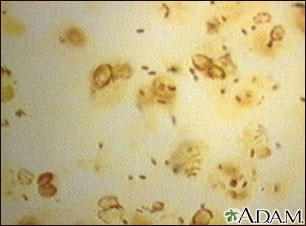With the Centers for Disease Control and Prevention cautioning about a recent uptick in “walking pneumonia” cases, what symptoms should you be on the lookout for? The CDC indicated earlier this month that infections from mycoplasma pneumoniae have been increasing, particularly among young children, since spring, with case numbers peaking in late August, reaching their […]


With the Centers for Disease Control and Prevention cautioning about a recent uptick in “walking pneumonia” cases, what symptoms should you be on the lookout for?
The CDC indicated earlier this month that infections from mycoplasma pneumoniae have been increasing, particularly among young children, since spring, with case numbers peaking in late August, reaching their highest levels in months. This bacteria can result in a form of pneumonia as well as other respiratory illnesses.
“The percentage of patients released from emergency departments with a diagnosis of M. pneumoniae-associated pneumonia or acute bronchitis has been rising for the past six months, peaking in late August,” the CDC noted in a notification on Oct. 18.
Specialists stated that the surge began nationally in the spring and commenced in June in Illinois.
“It’s truly significant,” Dr. Sharon Welbel, the director of Hospital Epidemiology and Infection Control at Cook County Health, expressed to NBC Chicago. “A notable rise in mycoplasma pneumoniae this year compared to last … but also a particularly significant increase among children aged 2 to 4. This is new.”
Here’s what to be aware of:
What is mycoplasma pneumoniae?
Mycoplasma pneumoniae is identified as a frequent cause of “mild respiratory illness.” This bacterium can infect several parts of the body, although it is most commonly associated with respiratory tract infections, which can “harm the lining of the respiratory tract, such as the throat, trachea, and lungs.”
What is ‘walking pneumonia’?
While the CDC mentions that infections are usually mild and may manifest only as a chest cold, they can also progress to pneumonia, albeit not the typical kind.
“When an M. pneumoniae infection advances to pneumonia, it is generally a less severe variant of bacterial pneumonia often referred to as ‘walking pneumonia,'” reported the CDC.
Such situations refer to individuals with pneumonia who “appear better than one might expect for someone suffering from a lung infection.”
“As symptoms are mild, individuals may not confine themselves to home or stay in bed. This is how the term ‘walking pneumonia’ came about,” the CDC stated.
Who is most exposed?
The latest trend indicates a change from past years as cases are typically noted in school-age children and teenagers, according to the CDC.
“M. pneumoniae infections can affect people of any age, but they most frequently occur in children aged 5–17 and young adults,” the CDC reported.
However, data from March 31 to Oct. 5 of this year showed a rise “across all demographics” in the U.S., peaking in August and sustaining elevated levels in the subsequent months.
The increase was most pronounced among children aged 2-4, where cases surged from 1% to 7.2%. For children aged 5-17, the rise was from 3.6% to 7.4% during the same period.
“The increase in children aged 2–4 is significant because M. pneumoniae has historically not been recognized as a main cause of pneumonia in this age group,” noted the CDC.
In total, such infections are not rare, with an estimated 2 million cases recorded annually in the U.S. However, precise figures remain elusive, as there is no national reporting or tracking system for these infections.
Cases usually rise in the summer and early autumn, as per the agency.
What symptoms should you be vigilant for?
Symptoms of infection can differ based on age and severity of the infection. Some might exhibit no symptoms, while others may show signs similar to a chest cold or pneumonia. Symptoms in children can also vary.
Generally, symptom onset can take from one to four weeks after exposure to the bacteria, with symptoms lasting several weeks.
Here’s what the CDC advises to observe:
Common symptoms encompass:
- Fatigue
- Fever
- Headache
- Cough that progressively worsens
- Sore throat
Symptoms in children
Instead of chest cold symptoms, children below 5 years of age may experience:
- Diarrhea
- Sneezing
- Sore throat
- Stuffy or runny nose
- Vomiting
- Watery eyes
- Wheezing
Pneumonia or ‘walking pneumonia’ symptoms
Common symptoms include:
- Cough
- Fatigue
- Fever and chills
- Difficulty breathing
How does it transmit?
The CDC states that the bacteria spread via inhaling respiratory droplets from an infected individual. However, these infections generally have a prolonged incubation period, with symptoms not emerging until one to four weeks post-exposure.
The bacteria can also linger in the respiratory tract for months following infection.
“Most individuals who spend a brief period with someone ill with M. pneumoniae do not become infected. However, those who spend an extended amount of time with an infected individual are at heightened risk,” reported the CDC.
How is it managed?
Dr. Welbel noted that mycoplasma pneumoniae is often classified as an “atypical bacteria,” meaning some antibiotics might not be effective against it.
“We typically refer to it as an atypical bacteria because it lacks a cell wall,” she explained. “This is crucial since many antibiotics function by attacking the cell wall, hence knowing which antibiotics to utilize is essential.”
The CDC also highlighted that “M. pneumoniae bacteria are inherently resistant to specific antibiotics that are routinely employed to tackle other types of bacterial pneumonia.”
The CDC added that while many individuals will recuperate independently, over-the-counter treatments may provide relief.














